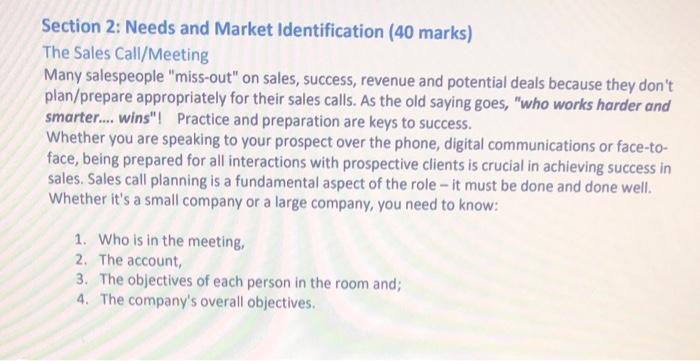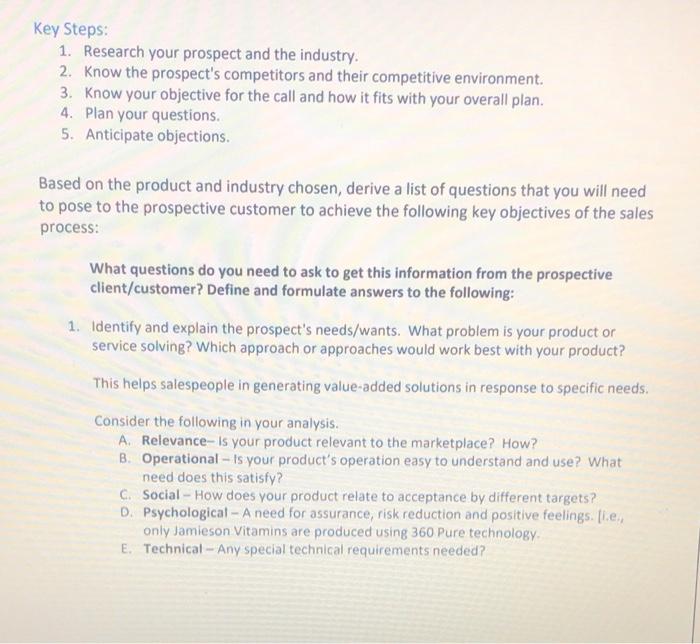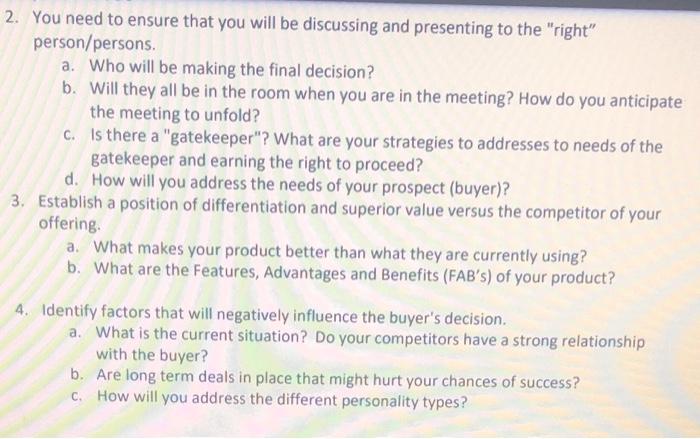Answered step by step
Verified Expert Solution
Question
1 Approved Answer
my product for this question is teach wear - HEADPHONES. and all the questions are on it Section 2: Needs and Market Identification (40 marks)
my product for this question is teach wear - HEADPHONES. and all the questions are on it 


Section 2: Needs and Market Identification (40 marks) The Sales Call/Meeting Many salespeople "miss-out" on sales, success, revenue and potential deals because they don't plan/prepare appropriately for their sales calls. As the old saying goes, "who works harder and smarter... wins"! Practice and preparation are keys to success. Whether you are speaking to your prospect over the phone, digital communications or face-to- face, being prepared for all interactions with prospective clients is crucial in achieving success in sales. Sales call planning is a fundamental aspect of the role - it must be done and done well. Whether it's a small company or a large company, you need to know: 1. Who is in the meeting, 2. The account, 3. The objectives of each person in the room and; 4. The company's overall objectives. Key Steps: 1. Research your prospect and the industry. 2. Know the prospect's competitors and their competitive environment. 3. Know your objective for the call and how it fits with your overall plan. 4. Plan your questions. 5. Anticipate objections. Based on the product and industry chosen, derive a list of questions that you will need to pose to the prospective customer to achieve the following key objectives of the sales process: What questions do you need to ask to get this information from the prospective client/customer? Define and formulate answers to the following: 1. Identify and explain the prospect's needs/wants. What problem is your productor service solving? Which approach or approaches would work best with your product? This helps salespeople in generating value-added solutions in response to specific needs. Consider the following in your analysis. A. Relevance- Is your product relevant to the marketplace? How? B. Operational - Is your product's operation easy to understand and use? What need does this satisfy? C. Social - How does your product relate to acceptance by different targets? D. Psychological - A need for assurance, risk reduction and positive feelings. ll.e. only Jamieson Vitamins are produced using 360 Pure technology E. Technical - Any special technical requirements needed? 2. You need to ensure that you will be discussing and presenting to the "right" person/persons. a. Who will be making the final decision? b. Will they all be in the room when you are in the meeting? How do you anticipate the meeting to unfold? C. Is there a "gatekeeper"? What are your strategies to addresses to needs of the gatekeeper and earning the right to proceed? d. How will you address the needs of your prospect (buyer)? 3. Establish a position of differentiation and superior value versus the competitor of your offering a. What makes your product better than what they are currently using? b. What are the Features, Advantages and Benefits (FAB's) of your product? 4. Identify factors that will negatively influence the buyer's decision. a. What is the current situation? Do your competitors have a strong relationship with the buyer? b. Are long term deals in place that might hurt your chances of success? C. How will you address the different personality types? Section 2: Needs and Market Identification (40 marks) The Sales Call/Meeting Many salespeople "miss-out" on sales, success, revenue and potential deals because they don't plan/prepare appropriately for their sales calls. As the old saying goes, "who works harder and smarter... wins"! Practice and preparation are keys to success. Whether you are speaking to your prospect over the phone, digital communications or face-to- face, being prepared for all interactions with prospective clients is crucial in achieving success in sales. Sales call planning is a fundamental aspect of the role - it must be done and done well. Whether it's a small company or a large company, you need to know: 1. Who is in the meeting, 2. The account, 3. The objectives of each person in the room and; 4. The company's overall objectives. Key Steps: 1. Research your prospect and the industry. 2. Know the prospect's competitors and their competitive environment. 3. Know your objective for the call and how it fits with your overall plan. 4. Plan your questions. 5. Anticipate objections. Based on the product and industry chosen, derive a list of questions that you will need to pose to the prospective customer to achieve the following key objectives of the sales process: What questions do you need to ask to get this information from the prospective client/customer? Define and formulate answers to the following: 1. Identify and explain the prospect's needs/wants. What problem is your productor service solving? Which approach or approaches would work best with your product? This helps salespeople in generating value-added solutions in response to specific needs. Consider the following in your analysis. A. Relevance- Is your product relevant to the marketplace? How? B. Operational - Is your product's operation easy to understand and use? What need does this satisfy? C. Social - How does your product relate to acceptance by different targets? D. Psychological - A need for assurance, risk reduction and positive feelings. ll.e. only Jamieson Vitamins are produced using 360 Pure technology E. Technical - Any special technical requirements needed? 2. You need to ensure that you will be discussing and presenting to the "right" person/persons. a. Who will be making the final decision? b. Will they all be in the room when you are in the meeting? How do you anticipate the meeting to unfold? C. Is there a "gatekeeper"? What are your strategies to addresses to needs of the gatekeeper and earning the right to proceed? d. How will you address the needs of your prospect (buyer)? 3. Establish a position of differentiation and superior value versus the competitor of your offering a. What makes your product better than what they are currently using? b. What are the Features, Advantages and Benefits (FAB's) of your product? 4. Identify factors that will negatively influence the buyer's decision. a. What is the current situation? Do your competitors have a strong relationship with the buyer? b. Are long term deals in place that might hurt your chances of success? C. How will you address the different personality types 


Step by Step Solution
There are 3 Steps involved in it
Step: 1

Get Instant Access to Expert-Tailored Solutions
See step-by-step solutions with expert insights and AI powered tools for academic success
Step: 2

Step: 3

Ace Your Homework with AI
Get the answers you need in no time with our AI-driven, step-by-step assistance
Get Started


